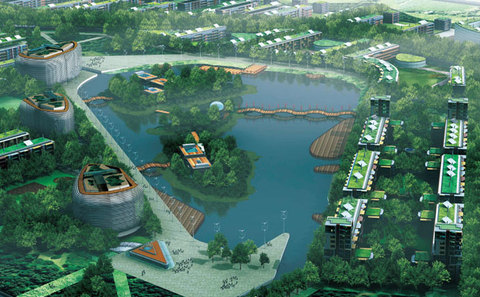Resource E
An article that takes a critical view of eco-cities.
Source: https://www.chinadialogue.net/culture/7934-Why-eco-cities-fail/en
Unless otherwise stated, this work is under Creative Commons' Attribution-NonCommercial-NoDerivs 2.0 England & Wales License and 2.5 China License.
Why eco-cities fail Jan McGirk 27.05.2015
A new book explores the failed promise of Dongtan eco-city outside Shanghai and why so many other ambitious green projects lie abandoned.

A mockup of the Dongtan eco-city outside Shanghai (Image by baike)
“The tension between China’s rise as a global power and its contribution to catastrophic environmental change is coming to a furious head,” author Julie Sze points out in her thought-provoking new book, Fantasy Islands.
Sze is a native New Yorker, but her father hails from Chongming Island in the Yangtze delta, which used to be dismissed as a rural backwater offshore from Shanghai before it was set aside to create Dongtan, an eco-city for half a million people.
Now a professor of American Studies at the University of California, Davis, Sze’s book examines many aspects of the “failed promise of Dongtan” and other developments around Shanghai, China’s largest urban area.
Pitched as a showcase ultra-green city to be ready and functioning in time for the 2010 Shanghai World Expo Dongtan was an ambitious joint project involving multinational engineering firm Arup and Chinese developers.
The scheme was conceived as a futuristic model for low-rise suburbs to accommodate spill over from super-cities and house China’s emerging middle class.
The project touted ‘zero emissions’ as one of its main selling points, and recycled waste was included in the myriad renewable energy systems planned for Dongtan. The city would ban carsr, recycle water and surround itself with organic farms, forests and golf courses.
The world’s longest bridge and tunnel now connects the wetlands building site and its looming wind turbines to Pudong, in outer Shanghai. Yet, five years after the World Expo the Dongtan dream has been abandoned.
The mega-project stalled in September 2006 after key officials were arrested for graft. Chen Liangyu, Shanghai’s top bureaucrat, was sentenced to 18 years in jail for bribery and fraudulent real estate transactions, while the former director general of the Shanghai Industrial Investment Corporation (SIIC), Wang Guoxiong, was given a life sentence for accepting bribes with his finance director Li Yizeng imprisoned for 15 years.
Most projects associated with the disgraced Chen have languished indefinitely, Sze points out, while permits for dozens of other major developments around China won approval. Many of the complications could have been avoided, Sze says. For example, Dongtang’s planners failed to comply with a government land use policy that required the local authority to reclaim an equal amount of property for any farmland used for development.
During this time, Chongming county officials were able to outpace the SIIC and proceeded to confiscate farmland, relocate peasants and invest in infrastructure.
“Green-building structures in Shanghai have become a symbol of technological and ecological sophistication in excess,” Sze adds, arguing that people’s behaviour and habits, such as family planning and diet, are just as vital as any cutting-edge engineering feats to sustain environmental improvements.
Sze’s scepticism about the wisdom of embracing an engineered “ecotopia”, and displacing entire populations in order to enable these large-scale fixes, underlines her analysis throughout this book.
Sze suggests corrupt officials aren’t the only ones to blame for Dongtan's setbacks. Big international engineering firms, she writes, may have avoided taking responsibility for flaws in some large flagship projects because they did not acknowledge how “technology, engineering and politics were intimately woven together.”
She points out those ambitious plans are not necessarily doomed to fail, even in view of China’s “sea of complex internal local and regional politics, not always apparent to outsiders.” To succeed, Sze says, the role of individual citizens must also be factored into such plans, too. Autocratic political structures may be able impose radical change but not sustain it indefinitely.
Sze argues that an authoritarian top-down approach to eco-development will likely flounder if it fails to come to terms with a municipal order that on the surface appears chaotic. “Sustainability…takes power and people seriously, rather than as an afterthought to the techno-fetishism that eco-desire inhabits, glorifies, and draws its breath from,” Sze writes with characteristic fervour.
“Chinese eco-desire is based on three closely linked factors: technocratic faith in engineering, reliance on authoritarian political structures to facilitate environmental improvements, and discourse of ‘ecological harmony’ between man and nature”.
The scale of Chinese eco-technological projects, meanwhile, still dwarfs most of their counterparts in Europe and North America, and in the age of climate crisis, western partners now compete to help modernise China’s megacities at the same time they try to counteract environmental degradation. Sze calls for more effective strategies and interventions, but she leaves these details up to the technicians.
Fantasy Islands: Chinese Dreams and Ecological Fears in an Age of Climate Crisis, gan Julie Sze, University of California Press







